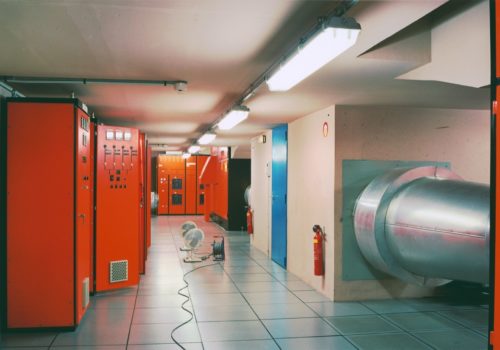Two years after the death of Lewis Baltz, one of the founding fathers of conceptual photography and crucial representative of the New Topographics movement, Brussels’ Museum of Contemporary Arts pays tributes to him by presenting Sites of Technology (1989-91), an emblematic series of the American artist that exposes the faults of a techno-scientific society where the invisible reigns supreme.
Critical observer of the world’s changes, Lewis Baltz was fascinated by both architecture and technology as a paradigm of human destruction. From the 1970s, he revolutionized landscape photography, which, through his sharp eye, changed into a “show” space of the growing influence of industrial zones and of homes on natural spaces.
Born in 1945 in Newport Beach, California, Lewis Baltz studied photography at the Art Institute of San Francisco from 1966 to 1969. He took his first photos during his adolescence. Already conceptual, these early works in black and white, with a “scientific precision”, would be christened Prototype Works. Quickly following nudes and still lifes, in 1967, his subjects testified to a “new world being born” made of depressing residential houses, Tracts Houses (1969-71) and industrial zones (The New Industrial Park Near Irvine, 1974-75). At twenty-six, he exhibited at the prestigious Leo Castelli gallery, thereby becoming the first photographer represented by the New York gallery owner.
Lewis Baltz was part of, along with Bernd and Hilla Becher and Stephen Shore, of the photography exhibition New Topographics : Photographs of a Man- Altered Landscape, organized in 1975 at the George Eastman House of Rochester by William Jenkins. This event marked a turning point in the art of photography, which, from the end of the 1970s, monopolized documentary approaches. With the series Maryland (1976), Park City (1978-81), and Nevada (1977), Lewis Baltz looked at architecture as a reflection of a society in transition. In 1988, he undertook what he himself called a “change of paradigm” and, working in France, Italy, and Japan, from that point forward he made photos moving closer to what became the epicenter of contemporary society: advanced technology.
Perfectly representative of this evolution, the Sites of Technology (1989-91) series is composed of a group of so-called “clean” industrial interior spaces: spaces at Grenoble’s National Weather Center; empty offices at Mitsubishi, Air France, and Toshiba; an anechoic room at France Telécom; a CERN supercomputer; a nuclear pool; even La Redoute servers in Lille. Through the eyes of Baltz, these brand-new high-tech spaces show their clinical and inhumane side. The function of these immaculate rooms populated with codes and data escapes us since by means of electronic imagery, technology becoming invisible. The more we look at these sites, the less we understand their function.
The artist sustains his conceptual intent with a synthetic approach to evolution. The color photography that he uses here for the first time in a complete series became an aesthetic language in its own right. A selection of colors were added by Lewis Baltz, with clear political preoccupations that favored the increasingly conceptual art of the 1990s. His prints, which no longer have the comforting distance of black and white, are disturbing. The large formats used for Sites of Technology reenforce the immersive dimension of the work and puts us in the heart of a current science-fiction. Drawing from the pictorial universes of Gerhard Richter, John McLaughlin, and even Sol LeWitt, Sites of Technology translates Lewis Baltz’s concern facing the dependance and vulnerability of man.
Jérôme André
Jérôme André is manager of conservation services at Brussel’s Museum of Contemporary Arts in Belgium.
Lewis Baltz, Sites of Technology 1989-91
Musée des Arts Contemporains (MAC’S)
February 19 through May 21, 2017
Site du Grand-Hornu
Rue Sainte-Louise, 82
B-7301 Hornu
Belgium
















